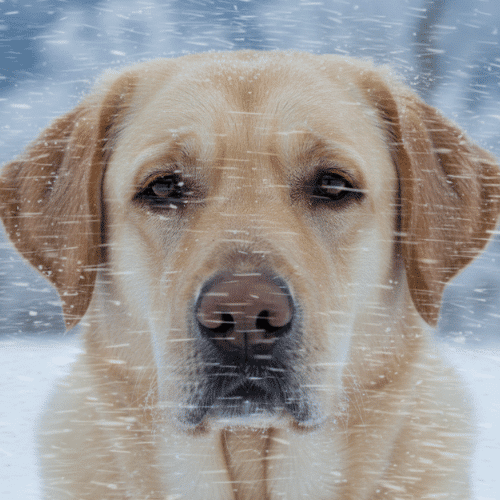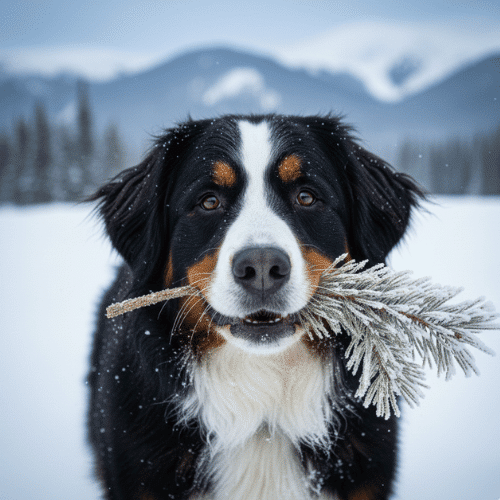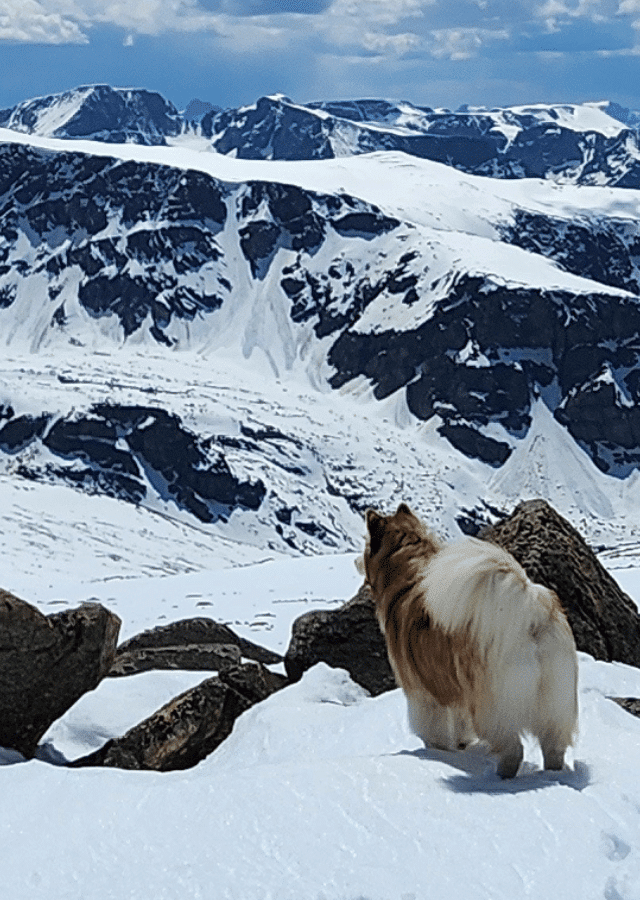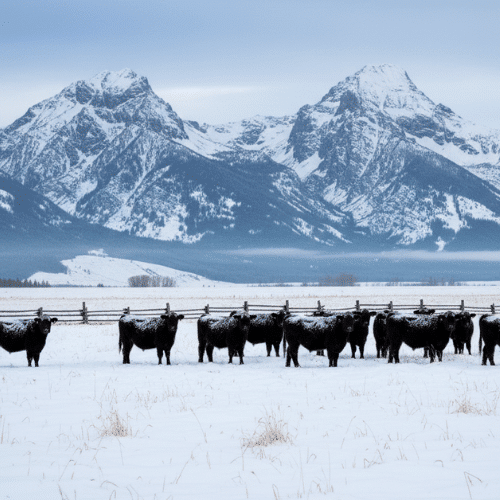Winter Pet Safety Tips: How to Protect Your Pets in Montana’s Cold Weather

Why Winter Pet Safety Matters in Montana
Montana winters bring freezing temperatures, sharp wind chills, and unpredictable weather patterns that can be harsh on pets. Even animals with wooly coats can struggle to stay warm when temperatures drop well below freezing. Understanding these seasonal risks helps owners make informed decisions that keep their pets safe and comfortable.
Sudden temperature drops, wind chill, and moisture rapidly increase heat loss in pets, including those with thick fur. These environmental factors are also noted in national cold-weather pet safety guidelines, which emphasize the importance of limiting exposure during extreme conditions.
How Cold Is Too Cold for Pets?
Most pets begin to feel uncomfortable when temperatures fall below 32°F, and small breeds, senior pets, and those with short coats may be at risk even sooner. Once temperatures hit 20°F or lower, dogs and cats can experience frostbite on ears, paws, and tails in a matter of minutes—especially if they get wet or exposed to wind.
Understanding Wind Chill and Montana Temperature Drops
Wind chill can make the air feel significantly colder than the actual temperature, increasing the risk of hypothermia and frostbite. In Montana, sudden temperature swings and gusty conditions can catch owners off guard. A dog who seems fine at first may quickly become dangerously cold once the wind sets in, and cats wandering outdoors can become disoriented or unable to find shelter.

Wind Chill Accelerates Heat Loss
Wind dramatically increases heat loss by stripping away the warm air layer surrounding the body. For example, at –10°F with a 20-mph wind, exposed skin (including a dog’s ears or a cat’s paw pads) can begin freezing in under ten minutes. This accelerated cooling is one reason Montana pets can become cold much faster than owners expect.
Quick Winter Pet Safety Takeaways
- Pets can experience frostbite when temps drop near or below 20°F
- Wind chill accelerates heat loss and increases danger
- Small, short-haired, senior, or underweight pets get cold fastest
- Wet fur (snow, slush, or baths) drastically reduces insulation
- Indoor/outdoor cats are at high risk during sudden Montana cold snaps
Signs Your Pet Is Too Cold
Early Signs of Discomfort
Pets may begin showing signs of cold stress even before temperatures feel extreme to humans. Early signs include shivering, whining, lifting their paws off the ground, slowing down on walks, or seeking shelter. Cats may hide, crouch low, or refuse to move if they’re too cold.
Frostbite: What Owners Need to Know
Hypothermia: Symptoms and When to Seek Immediate Care
Hypothermia happens when a pet’s body temperature drops dangerously low. Mild hypothermia causes shivering, lethargy, and stiffness. Moderate to severe hypothermia can lead to confusion, slow breathing, low heart rate, collapse, or unconsciousness. Any pet showing these signs should be brought indoors immediately and evaluated by a veterinarian.

Montana Holds Two Winter Records
Montana not only recorded the coldest temperature in the lower 48 states at -70°F in Rogers Pass (1954) but also experienced one of the most dramatic temperature swings in U.S. history. In Loma, Montana, temperatures rose from -54°F to 49°F within 24 hours, a staggering 103-degree change. These extremes highlight how quickly conditions can shift in Montana, increasing the risk of cold stress and frostbite for pets caught outside during sudden weather changes.
Quick Warning Signs Your Pet Is Too Cold
- Shivering, trembling, or curling up tightly for warmth
- Lifting paws off the ground or refusing to walk
- Pale or cold ears, paws, or tail tips
- Slowed movements, confusion, or weakness
- Persistent whining, pacing, or trying to head back indoors
- Wet fur or exposure to wind increases risk dramatically
Keeping Dogs Safe in Cold Weather
Montana winters can be harsh on dogs, even those with thick or double coats. Freezing temperatures, snowpack, ice, and chemical de-icers all raise the risk of cold-related injuries. With a few simple precautions, you can help keep your dog safe and comfortable during the coldest months of the year.
Dressing Dogs for Montana Winters
Safe Outdoor Time: How Long Is Too Long?
When temperatures fall below freezing (32°F), most dogs should only be outside for short, supervised periods. Once it approaches 20°F or colder, bathroom breaks should be quick, especially for small breeds or dogs with short fur. Wind, moisture, and cloud cover can make it feel colder than it is, so always err on the side of caution.
Paw Care Tips for Salt, Ice, and Snow
Ice melt products, snowpack, and jagged ice can cause irritation, dryness, or cuts on paw pads. After each walk, wipe your dog’s paws to remove salt and chemicals. Regularly check for cracks or packed snow between the toes, and apply a paw balm to maintain healthy pads. Keeping nails trimmed improves stability on slippery ground.
Vehicle Safety During Winter
Cold cars cool down rapidly once the heat is off, creating dangerous conditions similar to summertime heat risks. Snow-blocked tailpipes can also cause carbon monoxide buildup if a car is idling. Dogs should never be left unattended in a vehicle during winter, even for short periods.

Hiking with Dogs in Winter
Winter hikes can be an enriching experience for dogs, but Montana’s rugged terrain and cold conditions require extra caution. Be sure to help keep your doggo hydrated! Keep hikes shorter during extreme cold, bring plenty of fresh water, and watch for signs of fatigue or paw discomfort. Snow can hide hazards like ice patches, sharp rocks, or sudden drop-offs, so maintaining close supervision is essential. Even hardy breeds like Malamutes, Huskies, and other northern dogs need attention during winter treks. Their thick coats provide insulation, but snow can still accumulate between their toes and form painful ice balls. Using paw wax such as Musher’s Secret can help protect their pads and prevent snow buildup. Always check paws during and after hikes, and avoid pushing even cold-weather breeds too far.
Quick Dog Safety Tips for Winter
- Limit outdoor time when temperatures drop below freezing
- Dress vulnerable dogs in winter coats or booties
- Wipe paws after every walk to remove salt and chemicals
- Avoid letting dogs roam near roads or driveways where antifreeze may be present
- Keep walks supervised and watch for shivering or paw-lifting
Keeping Cats Safe in Cold Weather
Cats are especially vulnerable during Montana’s frigid winters! Whether they live indoors, outdoors, or somewhere in between. Understanding how to keep them warm and safe can prevent frostbite, hypothermia, and winter-related injuries.
Protecting Indoor-Only Cats
Indoor-only cats can still feel temperature drops indoors, especially near windows, drafty areas, or unheated rooms. Provide warm bedding, elevated perches away from cold floors, and ensure your home stays at a comfortable temperature. Senior cats and those with arthritis may struggle more in the cold and often benefit from extra warmth.
Outdoor/Indoor-Outdoor Cat Safety
Cats that spend time outside are at the highest risk during winter. Limit outdoor access when temperatures fall below freezing, especially at night. Encourage your cat to come inside before dark, when temperatures plummet further. For cats who insist on outdoor time, provide insulated shelters with bedding and ensure access to unfrozen water.
Preventing Frostbite in Cats
Cats can develop frostbite quickly on their ears, nose, tail, and paw pads. Damp fur, walking through snow, or being exposed to wind accelerates heat loss. If your cat returns home with cold extremities, slowly warm the affected areas with a towel or your hands and never use hot water or heating pads.
Quick Cat Safety Tips for Winter
- Bring cats indoors before temperatures drop below freezing
- Keep indoor cats away from drafty windows and cold floors
- Provide insulated outdoor shelters only if necessary
- Check paws, ears, and tails for signs of frostbite
- Tap the hood before starting your car to prevent injuries
- Store antifreeze and chemicals safely out of reach
Winter Safety for Small Mammals, Reptiles & Exotic Pets
Small mammals, reptiles, and other exotic pets rely heavily on stable indoor environments, especially during Montana’s cold winters. Sudden drops in room temperature can affect digestion, respiratory health, and overall wellness. Species like rabbits, guinea pigs, snakes, lizards, and birds each have unique needs, but they share one thing in common: they are far more sensitive to cold stress than dogs or cats.
Because many exotic pets depend on precise heat and humidity ranges, even minor shifts in your home’s environment can create stress. Winter air becomes significantly drier when homes are closed up and heaters run continuously, which can be harmful for tropical species that require consistent humidity. Reptiles may also struggle to digest properly without adequate warmth, while birds can become lethargic or susceptible to illness when air quality declines or drafts occur.
Owners should also be cautious about providing too much heat. Heat lamps, ceramic emitters, and under-tank heaters can all cause burns if they are not properly shielded or regulated. Physically checking the temperature of basking spots, monitoring thermostats, and using reliable thermometers and hygrometers are essential steps to prevent overheating and thermal injuries.
Exotic Pet Vet?
Winter Care Tips for Exotic Pets
- Keep enclosures away from windows, drafts, and exterior doors
- Use thermostats or temperature controllers to maintain heat consistency
- Provide extra bedding for rabbits and small mammals
- Ensure reptiles have reliable heat sources and UVB lighting
- Monitor humidity levels for reptiles and birds
- Avoid using space heaters near enclosures
- Pre-heat your car before a vet visit
- Have backup heating solutions ready during power outages
Caring for Rural Backyard Pets in Montana Winters
Backyard animals like chickens, ducks, small goats, and miniature livestock face unique winter challenges in Montana’s extreme cold. While they are not patients typically seen at Caring Hands, many pet owners care for mixed groups of household and rural animals and may benefit from general winter guidance. Ensuring dry bedding, proper shelter, and protection from freezing temperatures can make a significant difference in their winter health.
These animals rely heavily on well‑insulated coops, barns, or sheds to escape wind, snow, and subzero temperatures. Chickens and birds need ventilation without drafts to prevent moisture buildup, while goats require dry bedding and secure shelters that block wind. Ensuring access to unfrozen water is crucial for all species during long stretches of freezing weather.

Frostbite in Larger Mammals
Severe Montana cold snaps routinely affect livestock, with ranchers historically reporting frostbite on ears and tails of cattle during subzero stretches. Mammalian tissue freezes the same way regardless of species, which means dogs and cats are vulnerable under similar conditions. Understanding how cold impacts larger animals helps reinforce why short outdoor exposure limits matter for pets.
Common Winter Hazards for Montana Pet Owners
Montana winters introduce several hazards that can put pets at risk both outdoors and inside the home. Antifreeze is one of the most dangerous winter toxins, its sweet taste attracts animals, but even small amounts can be fatal. Organizations like the American Red Cross also warn that antifreeze is a deadly winter hazard for pets and recommend wiping up any spills immediately. Ice melt products and road salts can irritate paws or cause stomach upset if licked, and pets may accidentally ingest these chemicals while grooming after a walk.
Indoor hazards also increase during colder months. Space heaters, fireplaces, and wood stoves can burn curious pets, while dry winter air may contribute to dehydration and respiratory irritation. Water bowls may freeze outdoors, reducing access to fresh water, and icy surfaces can lead to falls and injuries. Being aware of these seasonal risks helps pet owners take simple steps to keep their animals safe.
Keeping Pets Comfortable Indoors
Keeping pets warm and comfortable indoors is essential during Montana’s cold months. Provide soft bedding in draft-free areas and avoid placing beds near exterior doors or windows where temperatures fluctuate. Heated pet beds or self-warming blankets can help seniors, arthritic pets, or thin-coated animals maintain body warmth without overheating.
Winter can also reduce activity levels, so maintaining hydration and proper nutrition is important. Pets may drink less in colder months, and dry indoor air can worsen this, so offer fresh water frequently. Mental stimulation—such as puzzle toys, short training sessions, and interactive play—helps reduce winter boredom and keeps pets engaged when outdoor time is limited.
When to Call the Vet for Winter-Related Concerns
Winter conditions in Montana can escalate from uncomfortable to dangerous quickly. If your pet shows signs of frostbite, hypothermia, or has been exposed to antifreeze or other toxins, immediate veterinary attention is crucial. Trust your intuition! If your pet seems off, sluggish, painful, or unusually cold, it’s always safer to have them checked.
Preventive Winter Wellness at Caring Hands
Regular checkups during the winter months help ensure your pet stays healthy despite the harsh conditions. Our veterinarians can assess weight, coat health, paw condition, and any cold-weather sensitivities to help you create a winter care plan tailored to your pet.
- Pale, cold, or discolored ears, paws, or tail tips (possible frostbite)
- Persistent shivering, weakness, or disorientation
- Slow breathing, low energy, or difficulty walking (possible hypothermia)
- Vomiting, seizures, or collapse after possible toxin exposure
- Snow or ice packed between paw pads causing pain or limping
- Any sudden behavior change following time outdoors
Book Your Winter Wellness Visit
Our team at Caring Hands Veterinary Hospital is here to help your pets stay warm, safe, and healthy all season long. If you’re concerned about winter-related symptoms or want personalized advice, schedule a visit today.
Call Our Caring Team
We're here to answer your post-surgery questions and help you schedule care.
Book Online Anytime
Whether it's surgery, a recheck, or general advice—we’ve made booking simple.
About the Author

Dr. Erin Maxted, DVM
Written by Dr. Erin Maxted, DVM, who now works in the wildlife veterinary field and collaborates with Caring Hands to ensure our educational content remains accurate and up to date.

Dr. Erin Maxted, DVM
Written by Dr. Erin Maxted, DVM, who now works in the wildlife veterinary field and collaborates with Caring Hands to ensure our educational content remains accurate and up to date.






